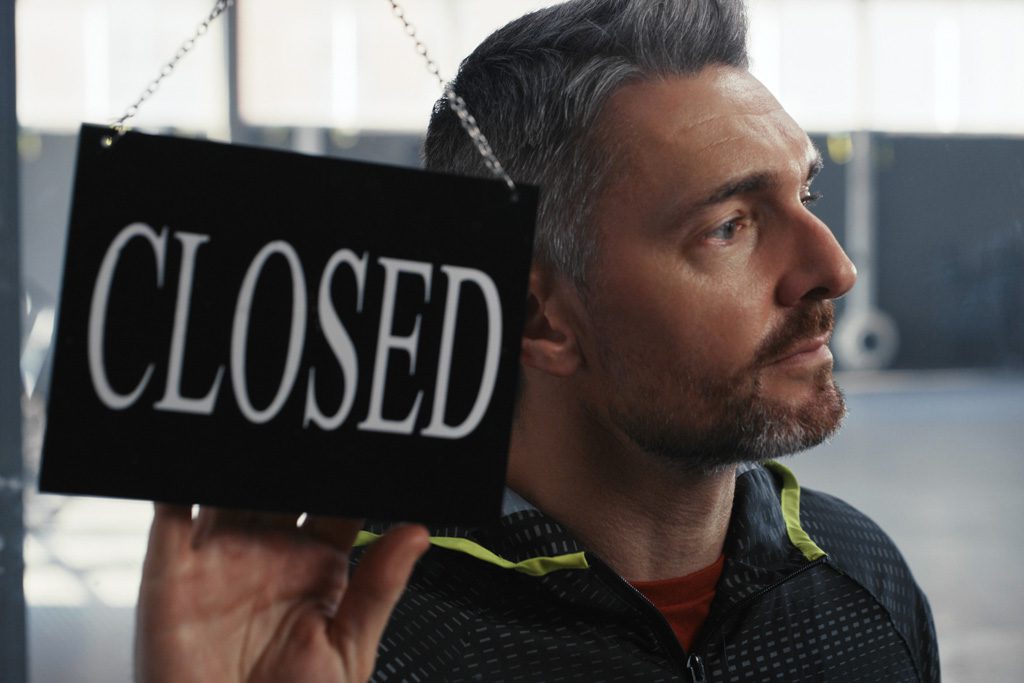That nearby gym is closing—so what do you do?
Let’s get the awkward part out of the way first:
You wouldn’t mind picking up some of the closing gym’s members, right?
It’s OK to admit it. No gym owner would decline the addition of 10 or 15 high-value fitness aficionados who want nothing more than to train hard with a coach for the next two years.
It’s a huge mistake to covet another gym’s members—and it’s wrong to poach them or hope another business fails. Your best market opportunity is the army of people who aren’t working out right now, not the relatively tiny number of people who are already training at gyms.
But I’ll give you permission to work on acquiring the members of a closing gym.
In fact, I’ll suggest it’s your duty to do so.

A qualifier: You do not want every single member of every single gym that closes.
It would be a mistake to think that your coaching gym for families will be a hit with powerlifters. Access clients who only want to wear out treadmill belts won’t be interested in your personal training sessions. And so on. You only want “the right members,” not every member.
But when a gym closes and leaves members who are just like yours hanging, it isn’t wrong to try and help them.
“Help” is the key word here. Don’t put your business first. If you do, you’re inching toward the dark side of gym ownership, which is ruled by greed, jealousy and the scarcity mindset.
Helping is different. Here’s the reality: A whack of people who are using fitness to stay healthy and accomplish their goals no longer have a place to do that. They’ve lost their fitness home, which was a special place for many of them. They’re likely sad, disheartened and confused.
Many of them are in danger of heading back to the couch.
That’s where you come in.
You need to stop them from quitting exercise. You must keep them moving and help them accomplish their goals. You must keep them healthy. It is your duty to offer help at a difficult time.
Will your gym benefit if you get some new members? Sure. But that’s not your focus. Your goal is making sure people can get the fitness help they need.
I’ll give you a path to do so.
How to Help

First, if you feel squidgy about everything I’ve said here, read “Help First” by Chris Cooper. That will get your mind right. You aren’t selling, poaching, stealing or acting badly. You are helping.
Think of it like this: The good ship Gym Down the Street just sank, and its clients are holding onto chunks of wood in deep water. You have room on your seaworthy vessel. The next move is obvious, right?
Your rescue plan comes courtesy of Matt Michaud, who runs EverProven in New Hampshire. Three gyms near his have gone under, and he’s got experience helping people in this situation.
Matt recommends reaching out to the owner of the closing business first. This isn’t about buttering someone up so you can acquire members. It’s about asking if you can help a struggling entrepreneur out in a tough time. They now need a place to work out, too, right? Focus on the person and proceed in service and with empathy.
This person is just like you. Imagine it from the other side: Your business is failing, but you still feel invested in your members. You don’t want to abandon them. How would you feel if you knew they would be cared for in another business? Still bad—but much better, right? At least you can tell Tim, your client of three years, where he can go to ensure he keeps moving toward his goal of 100-lb. weight loss.
When Matt contacted an owner and the coaches of a closing gym, he ended up hiring one trainer whose job was about to vanish. That’s job preservation—and I’m sure the coach was grateful Matt made a phone call. The hire probably eased the guilt of the other owner, too.
From there, and hopefully with permission, reach out to the people who don’t have a place to train. You can do this through friends or simply with public posts. In the best case, the departing owner connects you to their clients as a final act of service to them.
You’ll end up talking to many of the closing gym’s clients, and after you hear what they want and need, be a fitness pro: Tell them how to accomplish their goals. If you need to say “our gym isn’t the best place for you,” say that and tell them where to go.
But if your gym is the place where they can reach their goals, say that. Then do everything in your power to integrate the new people into your community. Remember that they lost something precious—a familiar, safe third place. Go out of your way to help them thrive in your business.
Act Now
You know what’s even easier than making first contact with the owner of a failing business?
Having coffee with a gym owner tomorrow.
Why not reach out and ask how you can help before a business is in trouble? At the very least you’ll make a new contact and remove the us-vs.-them attitude. At best, you’ll add to your referral network and acquire a contact who can help you get more people moving in your city: “Want to partner for an event to try and reach inactive people nearby?”
A while back, another gym owner, Ian Smith of Mountain Speed, Strength and Fitness in Colorado, took coffee to the owner of a new gym down the street. He did this in a small town, where it’s tempting to think the area doesn’t have enough clients to fill all the gyms.
Ian offered some tips and made a friend, and he did it while his gym was growing from $800 a month in revenue to $25,000. So clearly the town had enough clients for everyone.
This is the Help First principle in action, with a strong dose of the abundance mindset.
If a gym nearby fails, reach out and offer to help. But before that happens, reach out and offer to help, too.
Remember, a rising tide lifts all boats, and your community needs more strong gyms, not fewer.
And if a gym does go under, don’t sit idle. Some of its clients will need you to keep them from flopping back on the couch.

